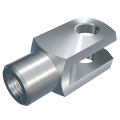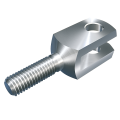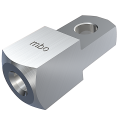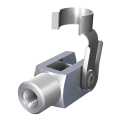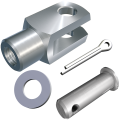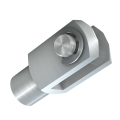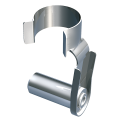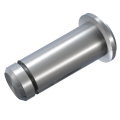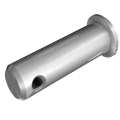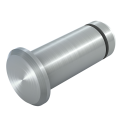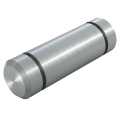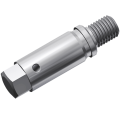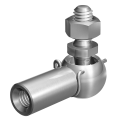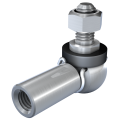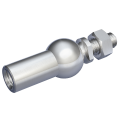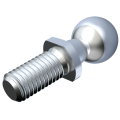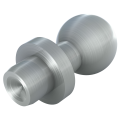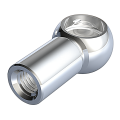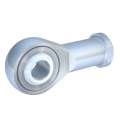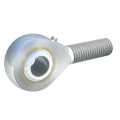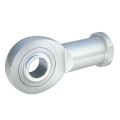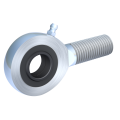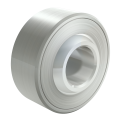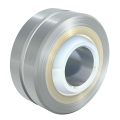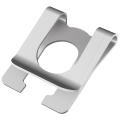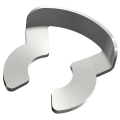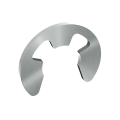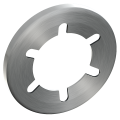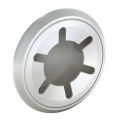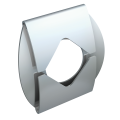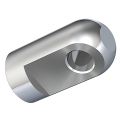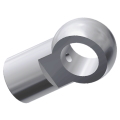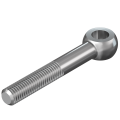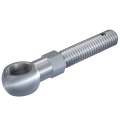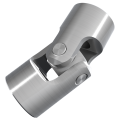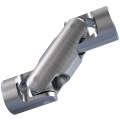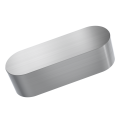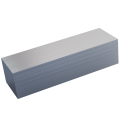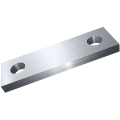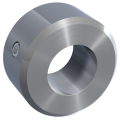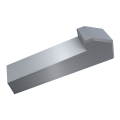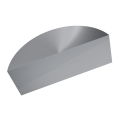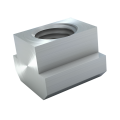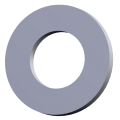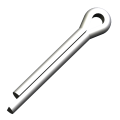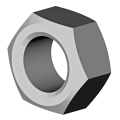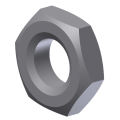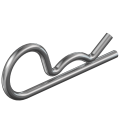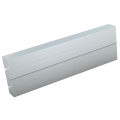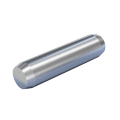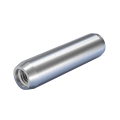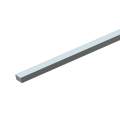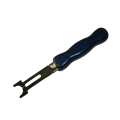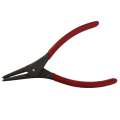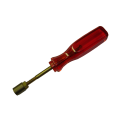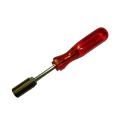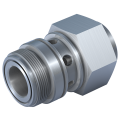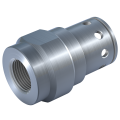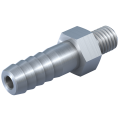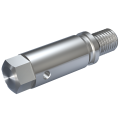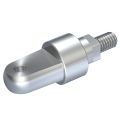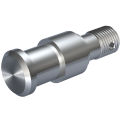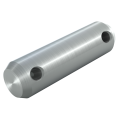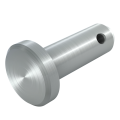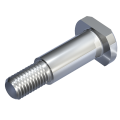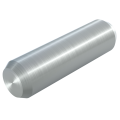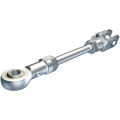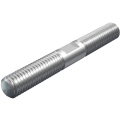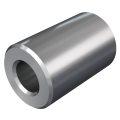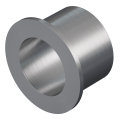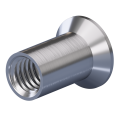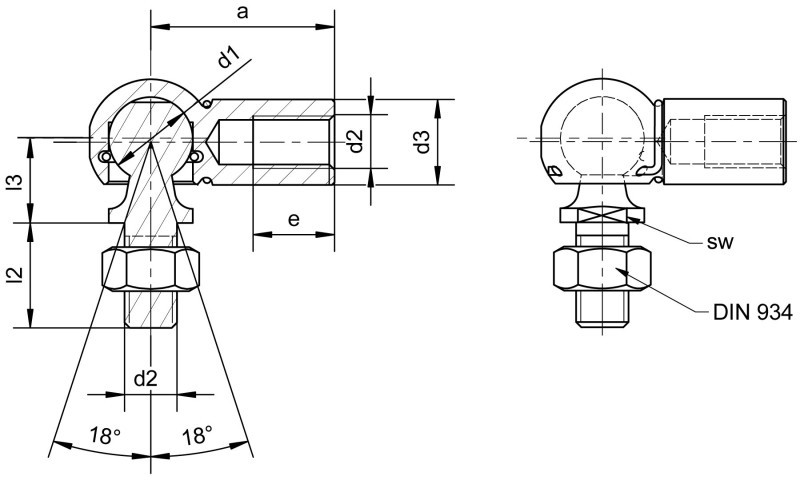Description
1. Product description
Angle joints (also known as ball joints or swivel joints or Faudi joint, see also Wikipedia) according to DIN 71802 form CS with threaded stud are mechanical corner connection and guiding elements, specially designed for flexible and reliable power transmission in various directions.
An angle joint is an assembly. The following enumeration describes the individual parts of the classic version according to DIN 71802:
- Ball socket DIN 71805
The ball socket encloses the ball stud and allows unrestricted freedom of movement in all directions. Its precise manufacturing ensures low-friction function and long-lasting stability. - Ball stud DIN 71803
The ball stud has an external thread and a spanner surface for easy assembly. It is inserted into the ball socket and ensures the necessary mobility of the joint. - Snap ring
This ring securely holds the ball stud in the ball socket and prevents unintentional release. - Circlip DIN 71805
The circlip additionally secures the ball stud in the ball socket, providing even more safety. - Sealing cap (optional)
Provides protection against dust, dirt, splashes, and fumes, extending the lifespan of the joints and reducing maintenance requirements. - Hex nut DIN 934
For fastening and additional securing of the ball stud. - Grease
To reduce friction between the ball stud and the ball socket and to extend the lifespan of the joint.
This version according to DIN 71802 in form CS is the most common design. Thanks to the use of an additional circlip, this joint provides increased safety against unwanted detachment, such as caused by a suspended installation.
With the design of the ball socket with an internal thread and the ball stud with a male thread, a simple combination with other components is ensured. The swivel angle is ±18°.
Overview video
We have also conveniently summarized the information below for you in a video:
2. Product details
Size: CS 8 M5 - CS 19 M16
Material group: Steel, stainless steel, stainless steel A4 quality
Surface: bright, electr. galvanised white
Thread version: Regular thread right and left, fine-pitch thread right
d1 Ball diameter: 8 - 19
d2 Thread: M5 x 0,8 - M16 x 2
Options
Thread: As a standard, both the ball socket and the ball stud variants are equipped with a right-hand thread. The norm assigns a corresponding thread size to each size of component.
Provided the geometry of the respective component allows it, different thread sizes or a metric left-hand thread are also possible. Moreover, for applications that require a more precise adjustment, the component can also be designed with a fine thread with a smaller pitch. All these mentioned thread options can, of course, be combined as desired.
Form C: Form C differs from form CS only because it lacks a safety clip, in which case the ball socket DIN 71805 form A is used.
Form CSL: Form CSL is the smooth-running variant of the angle joints DIN 71802 form CS. Using this smooth-running version reduces the frictional resistance between the ball socket and the ball stud. However, these joints inherently have increased ball play compared to the standard version.
Angle joint according to DIN 71802 form B and form BS with rivet stud: The Form B and form BS series according to DIN 71802 are fundamentally identical to the form C or form CS described above. The difference is that instead of a ball stud, a rivet stud is used. This is especially suitable when the joint is to be permanently connected to another component.
Similar to DIN 71803: Angle joints with spanner surface on the socket, angle joints with long ball socket or with sealing cap as well as angle joints with ball socket with slit are similar to DIN 71803 and complete the standard range of angle joints by mbo Osswald.
3. Application Areas & Compatibility
Angle joints are preferably used in applications where power transmission takes place as a corner connection. A significant advantage is that the joint, due to its component geometry, is movable in all directions. Consequently, power transmission in the application sometimes occurs only at specific points. Moreover, angle joints are often additionally used for angle and play compensation.
Typical fields of application include:
Mechanical engineering: In general mechanical engineering, angle joints are widely used as flexible and secure connections in various machines. Whether in production plants, conveyor technology, or robotics — wherever precise movements and flexible power transmissions are necessary, angle joints are employed. Their ability to transmit movements in different directions makes them an essential component for complex mechanisms and ensures high efficiency and longevity of the machines.
Agricultural and construction machinery: Agricultural and construction machinery must operate under harsh conditions and often withstand severe mechanical stresses. Angle joints are used here as movable linking elements in various machines and equipment, such as tractors, combine harvesters, or excavators. They enable reliable power transmission and mobility, which is necessary to effectively and safely carry out a wide range of work processes.
Rail industry: In the rail industry, angle joints are used in connections and axles. Particularly in the complex chassis constructions of trains, angle joints are indispensable as they ensure a flexible yet stable connection between the variably movable parts of the running gear systems. This contributes to the stability and safety of the vehicles, even under extreme loads and changing movements.
Medical and rehabilitation technology: In medical and rehabilitation technology, angle joints are used in movable components of medical devices and instruments. They provide the necessary precision and flexibility to enable complex movements and adjustments.
Energy and power plant technology: In power plants and other energy systems, angle joints are used to connect movable parts in turbines, pumps, and other machines. They enhance efficiency and safety by optimally balancing movements and vibrations.
Packaging and material handling technology: In the packaging and material handling technology, flexible and precise movements are indispensable. Angle joints are used in conveyors, filling systems, and packaging machines (e.g., on gas springs) to ensure continuous and smooth movement of materials and products.
Angle joints DIN 71802 form CS with threaded stud are versatile and indispensable components in numerous industrial sectors. Their ability to transmit forces and movements in various directions makes them particularly valuable for vehicle construction, the rail industry, agricultural and construction machinery, as well as general mechanical engineering. Their robust construction and high precision significantly contribute to the performance and safety of the respective applications.
4. Advantages and Benefits
High flexibility: Angle joints enable movements in multiple directions, making them particularly suitable for applications requiring multidirectional flexibility.
Easy assembly: The metric male thread on the ball stud and the metric female thread on the ball socket allow for easy and quick assembly, reducing installation time and increasing efficiency.
Robustness and durability: Made from high-quality steel or stainless steel, they offer high resistance against wear, corrosion, and other environmental factors, extending their lifespan.
Load capacity: These joints can handle mechanical loads, both static and dynamic, making them ideal for many applications.
Versatility: They can be used in numerous industries, e.g., in machinery and automotive engineering, railway, agricultural and construction machinery industry, medical technology, packaging, and conveying technology, among others, even for hobbyists and model builders.
Maintenance friendliness: Due to their robust and simple design and the materials used, little to no maintenance is often required, lowering operating costs.
Cost efficiency: By having a long lifespan and reducing downtime and maintenance costs, angle joints contribute to lowering overall costs. Additionally, the versatile standard versions enable cost-effective procurement and storage.
In summary, angle joints DIN 71802 form CS with threaded stud offer a multitude of benefits, making them a valuable component in numerous industrial applications. From high flexibility and load capacity to easy assembly and maintenance friendliness, to versatility and cost efficiency - these angle joints significantly contribute to the efficiency and reliability of the systems in which they are used.
5. Assembly and Installation
Assembly
The assembly of an angle joint according to DIN 71802 in form CS is carried out in the following steps:
- Insert grease into the cup of the ball socket
- Press the snap ring into the groove of the ball socket so that it can move freely
- Press the ball stud through the snap ring down into the ball socket until it snaps into place
- Install the circlip
- Optional: Screw a hex nut onto the thread of the ball stud (according to DIN 71802 the nut is provided loosely)
Installation
Angle joints are usually firmly connected with the adjacent components. The simplest form of connection occurs between the corresponding counterparts via the internal thread of the ball socket or the external thread of the ball stud. It's only necessary to consider a certain dimensional tolerance of the respective counterpart.
If a rivet stud is used instead of a threaded stud, appropriate machines and devices are required for installation. In this case, the stud is permanently riveted to the corresponding component beforehand. The associated ball socket is then fitted later.
Especially in automotive applications, press fitting has recently proven effective. The ball socket is precisely adapted to the element to be pressed. This could be a shaft or a wire, for example. The pressing process offers a quick and permanent component connection.
6. Safety instructions & Standards
Safety instructions
Observe load limits: Always ensure that the specified load limits of the angle joints are not exceeded to avoid mechanical failure and potential associated injuries.
Regular inspection: Conduct regular inspections and maintenance of the angle joints to ensure they are in perfect condition and show no signs of wear or damage.
Proper installation: Ensure that the angle joints are correctly and securely installed. Improper installation can lead to failures and safety risks.
Avoid overstrain: Avoid abrupt or extreme movements that could overstrain the angle joints.
Use appropriate fasteners: Use only appropriate and specified screws and nuts to fasten the angle joints. Inappropriate fasteners can impair function and safety.
Check material compatibility: Check whether the material used for the angle joints is suitable for the environmental conditions (e.g., corrosion, temperature).
Standards and norms for angle joints according to DIN 71802
DIN 71802: This standard specifies the requirements for angle joints, including dimensions, mechanical properties, and material requirements.
DIN 71805: This standard defines the requirements for ball sockets in terms of their dimensions, materials, and mechanical properties.
DIN 71803: This standard specifies all important dimensions and technical details for ball studs. Ball studs DIN 71803 are the essential counterpart to ball sockets DIN 71805 and together form an angle joint DIN 71802.
ISO 9001 (Quality Management Systems): The manufacture of the angle joints should be carried out under a certified quality management system according to ISO 9001 to ensure consistent quality and reliability.
Material Standards: The materials used should comply with the relevant material standards, such as DIN EN 10088 (stainless steels), to ensure that they possess the necessary mechanical and corrosion-resistant properties.
Adhering to the safety instructions and standards is crucial for the safe operation and longevity of angle joints according to DIN 71802 form CS. Regular inspection, correct installation, and the use of appropriate materials, as well as staff training, are essential to prevent accidents and failures. Observance of DIN, ISO, and material standards ensures that the angle joints meet high-quality and safety standards.
Fast-track this part (max. 400 units) through our production facility. Shorten the delivery time by 1-2 working days. We are currently exclusively testing this delivery service for Germany.
incl. VAT
plus shipping costs
To cancel your filter settings again, click on the "Clear" button below the table.
You can display product details, including the eShop function and 3D model , by clicking in the row corresponding to the required article.

